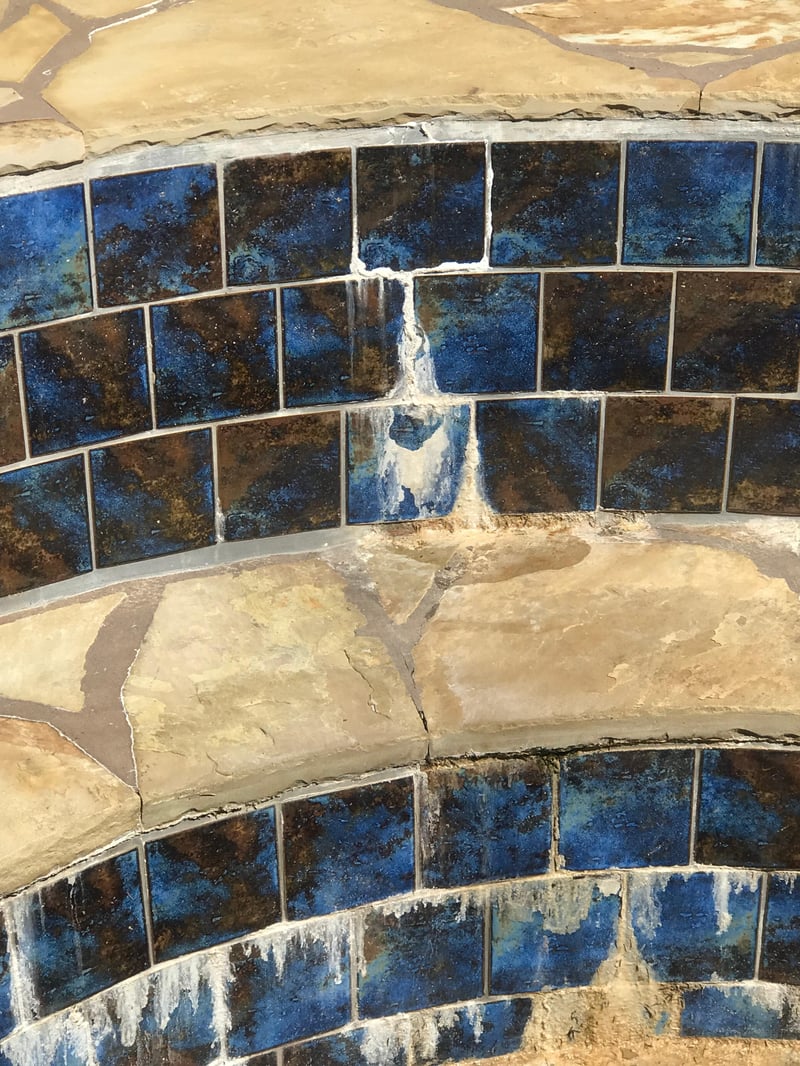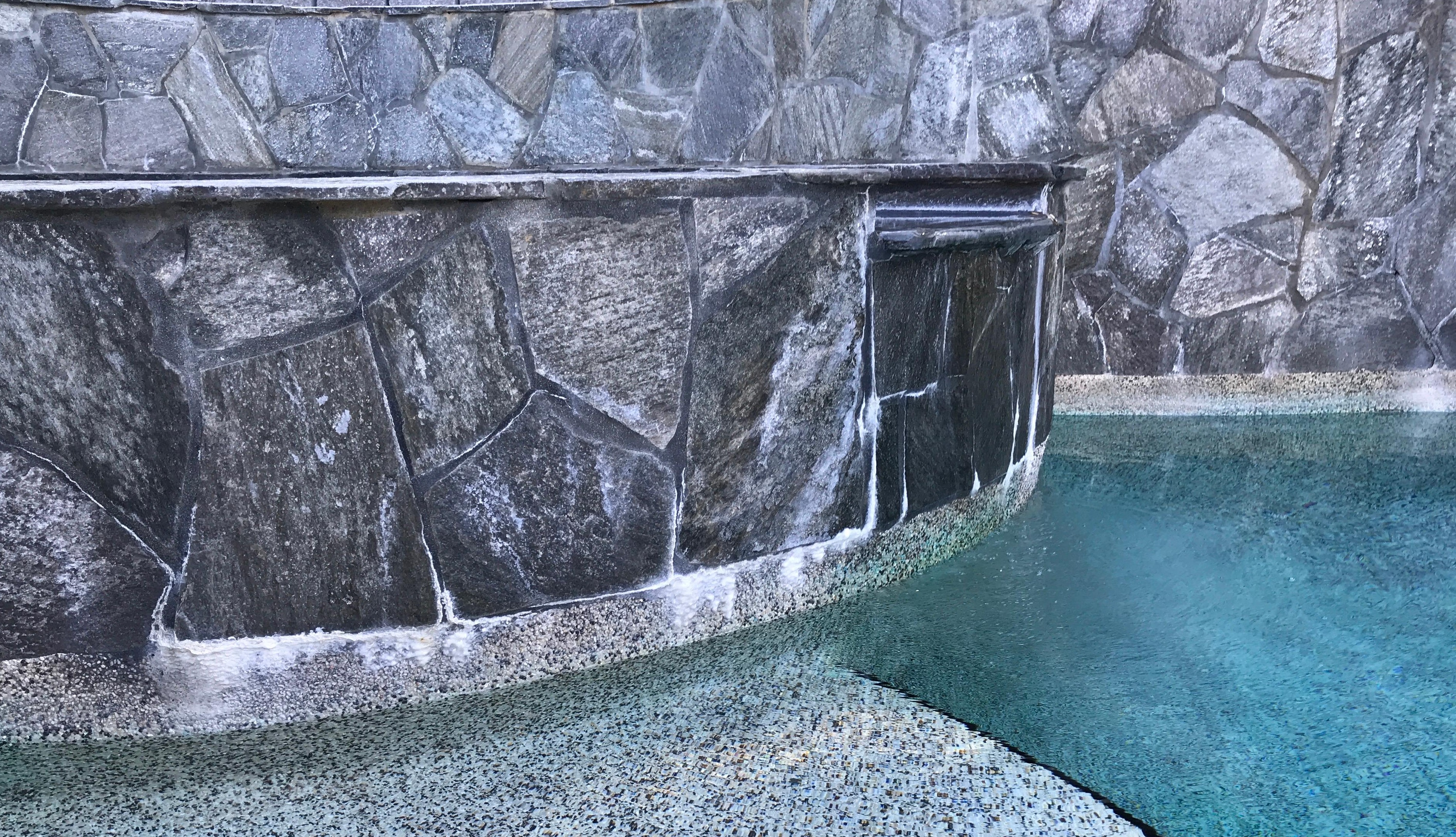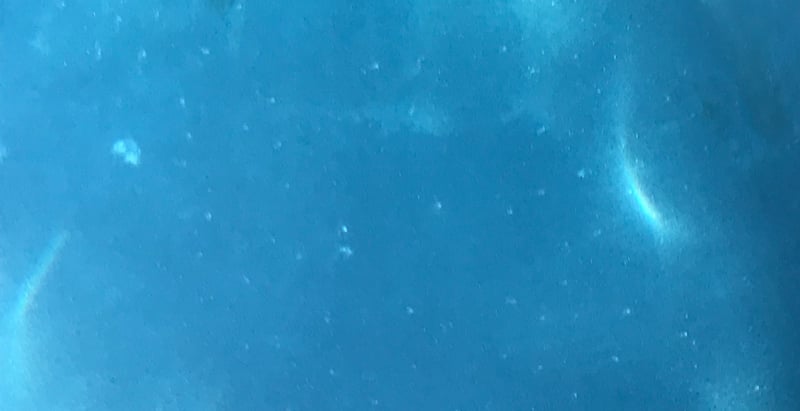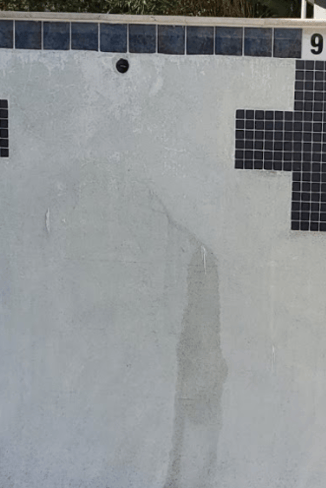Are Concrete Pools Waterproof?

Most people probably think swimming pools are waterproof. You might be surprised to learn that most pools are not actually waterproof. Sure, vinyl liner and fiberglass pools are, or at least should be. But in-ground concrete pools are not. In this article, let's discuss the process of waterproofing for concrete pools, and if waterproofing is necessary for your pool.
Covered in this article:
- Concrete is not waterproof
- Concrete density matters
- Do concrete pools need to be waterproofed?
- Raised walls
- High water table (groundwater)
- How to waterproof a pool
- Colloidal silica
- Waterproof membrane
- Conclusion
Concrete is not waterproof
Concrete is naturally porous and not waterproof. It actually absorbs water quite well, making it an ideal surface for airport runways, sidewalks, and pool decks. But when water absorption is not desired, like the shell of an in-ground swimming pool, higher density shotcrete is needed. Additionally, waterproofing products can be applied to densify and seal the concrete from absorbing moisture.
While the type of concrete is similar for all pools, its density and method of application can make a difference in its waterproofness (...is that a real word?).
Most concrete pool shells are made of pneumatically applied shotcrete. There are two ways to pneumatically shoot concrete:
- Dry mix with water added at the nozzle, called gunite, or
- Wet mix sprayed under pressure, called shotcrete.
The minimum concrete density needed (in pounds-per-square-inch, or PSI), according to Genesis and Watershapes University, is 4000 PSI, and 5000+ PSI for saltwater pools. This is much denser than a sidewalk or driveway. If such density is achieved, there is less porosity and therefore the concrete is more watertight.
Concrete density matters
According to master pool builder and Watershapes University instructor Paolo Benedetti of Aquatic Technology, properly applied shotcrete should be dense enough to be watertight, even if not technically waterproof. Most problems with concrete pool shells stem from weak shotcrete and bad application. We discuss these problems in-depth in another article.
If shotcrete is properly applied and has the right PSI (pounds-per-square-inch) density, according to Benedetti, additional waterproofing is unnecessary in the pool shell is in the ground.
Do concrete pools need to be waterproofed?
We spoke to many subject matter experts for this article, because Orenda is not in the concrete business. One such expert is Bill Drakeley of Watershapes University, who told us if shotcrete is properly applied and cured, usually waterproofing is not necessary for the shell in the ground. Too often, bad shotcrete application is the cause of water penetrating through the concrete shell. Bob Guarino of South Shore Gunite echoed this opinion. Bad shotcrete placement is a common problem, and a costly one to undo and redo.
Bill, Bob, and the other experts we asked noted some circumstances where waterproofing may make sense. One such circumstance is concrete out of the ground.
Raised concrete walls
The concrete above the ground is a different story from the in-ground pool shell. Think about raised spas, vanishing edge walls, and water features. These concrete walls are basically water retaining walls. Based on who we spoke with, in our opinion, raised walls should always have a pool waterproofing layer applied to them before plaster or tile are installed.
Raised spas and vanishing edge walls should be waterproofed on the inside and outside of the wall. This is to prevent moisture migration and efflorescence. We at Orenda get many calls about "scale", when in fact it's often efflorescence, caused by moisture penetrating through the concrete spa wall. Never underestimate hydraulic pressure.
 PHOTO: Failure to waterproof. Water pushes through concrete, creating efflorescence on the other side. In this case, a recessed firepit in the middle of the pool.
PHOTO: Failure to waterproof. Water pushes through concrete, creating efflorescence on the other side. In this case, a recessed firepit in the middle of the pool.
When concrete cracks on such raised walls, according to Vito, moisture will follow. "Concrete will eventually crack at a microscopic level, so adding a flexible membrane to seal it helps prevent moisture from pushing through the concrete."

PHOTO: Efflorescence looks like carbonate scale because it is also calcium carbonate (CaCO3). But it is from moisture pushing through the concrete wall of the raised spa, taking minerals with it to the outside.
If the pool itself is raised above the ground, such as a steep hillside, go ahead and waterproof everything you can. This is essential for rooftop pools too. We have seen some absolutely amazing pools off the edge of hills, and they need to be thoroughly waterproofed, just like a raised spa.
High water table (groundwater)
If the concrete pool shell is dense enough, it should be watertight, as we mentioned earlier. But what about water pressure from behind the shell? This was the topic of a few previous articles we have on weepers and calcium nodules. When the water table is high enough, groundwater can have enough pressure to push into the pool. This is not as rare as you might think. We see these problems most often in coastal areas, but also in Florida, Louisiana, and Houston TX, to name a few regions.
A brief note on calcium nodules is in the footnotes below.1 We have found a direct correlation between calcium nodules and a lack of waterproofing. If you have one or two nodules in your pool, the affected area is small, and perhaps isolated. But sometimes pools have hundreds or even thousands of calcium nodules. In our experience, most of these are caused by groundwater and a lack of waterproofing. So if you're in a coastal area or you know you have a high water table, Orenda strongly recommends waterproofing your entire pool before plastering.
 PHOTO: Thousands of tiny calcium nodules plagued this otherwise beautiful pool in a coastal town. Groundwater caused these, and the pool builder has since waterproofed every pool they build. No calcium nodules since.
PHOTO: Thousands of tiny calcium nodules plagued this otherwise beautiful pool in a coastal town. Groundwater caused these, and the pool builder has since waterproofed every pool they build. No calcium nodules since.
Weepers are a far more severe problem. Weepers are when water leaks into a pool through weaknesses in the concrete shell. This is usually from bad shotcrete installation, improper curing, and weak density. According to Bob Guarino of South Shore Gunite, weepers usually occur in the weakest parts of the concrete, which are often where the rebound is troweled back into the walls or floor. Rebound is the excess shotcrete material that does not adhere when the shotcrete is initially sprayed in place. Such excess is waste and should be discarded. Putting rebound back into the walls creates void spaces that water can travel through, causing weepers.
 Weepers are often accompanied by calcium nodules too because the flowing water takes minerals with it, and as it presses through the plaster, nodules can form. You may not notice a weeper at first when the pool is full (because who can see water trickling into water?), but when the pool is empty, they are readily visible.
Weepers are often accompanied by calcium nodules too because the flowing water takes minerals with it, and as it presses through the plaster, nodules can form. You may not notice a weeper at first when the pool is full (because who can see water trickling into water?), but when the pool is empty, they are readily visible.
PHOTO (Right): When the pool is drained, weepers are easy to spot, and often are the source behind a calcium nodule, as shown here.
How to waterproof a swimming pool
We interviewed concrete waterproofing expert Vito Mariano of Basecrete for this article. According to Vito, pool waterproofing is applied in stages, starting within 3 days of shooting the pool shell.
Colloidal silica
First, a colloidal silica2 is sprayed onto the fresh concrete and absorbs into the concrete, increasing its density. There is a ton of information online about colloidal silica (or colloidal silicates), and we will not go into detail here on how they work. Just know they are a valuable first step in the concrete waterproofing process.
Waterproof membrane
After at least 15 days, a waterproof membrane can be manually rolled onto the concrete. This membrane is flexible and adheres to the concrete, helping it maintain moisture. We are only paraphrasing this process because we are not experts in this space. So you should consult the waterproofing product manufacturer for specific instructions.
What's important here is to follow the instructions in order, and give the necessary time in between steps. Concrete curing takes time! Do not rush to apply the pool plaster if you have not given the concrete time to do its thing. Otherwise, it can crack and shrink behind the plaster, causing future problems.
Related: Optimize plaster cement curing with the Orenda Startup™
Vito agrees with the industry standard that concrete pool shells should be a minimum density of 4000 PSI, and he also added that the pool shell needs at least 28 days to properly cure. During these 28 days, adequate moisture is needed for the concrete to cure dense enough. This means wetting the pool shell regularly with a sprinkler, drip hose, or other mechanisms for watering the concrete.

PHOTO: Keeping concrete wet is essential during the first 28 days. It gives the concrete the moisture it needs to cure and densify. Photo courtesy of Schindler Design Company.
Conclusion
Is concrete waterproof? No. Can it be watertight? Yes, if it is dense enough, applied correctly, and cured properly. If the pool is in the ground with a solid 4000+ PSI concrete shell, perhaps waterproofing is unnecessary–unless your area has high groundwater. Raised concrete should always be waterproofed if they hold water. Concrete is porous, no matter how dense it is, and water can eventually work its way into it. That is unless you have added pool waterproofing layers to it.
We do not have direct expertise with concrete shells. We at Orenda only wrote about this because many problems we are called about are related to weaknesses with the concrete pool shell itself. And as we are establishing the best practices for pool chemistry, we also want to share best practices for pool materials and construction. To do this, we have asked the experts, and they were gracious to share their knowledge with us so that we can share it with you.
Now that we have an informed opinion, Orenda recommends waterproofing for every concrete pool. It's more money, yes, but whether you're a homeowner or pool builder, waterproofing is a cheap insurance policy against major problems that can occur. Why take the risk? Why not waterproof and be sure your vessel is watertight?
Some may think it's overkill, and that's fine. A local pool builder should know your soil better than we do. We're just saying it's an affordable way to reinforce the concrete pool shell, and we like that. Waterproofing, in our experience, has prevented most efflorescence and calcium nodule problems, which usually lead to a "chip out, waterproof, bond coat and re-plaster" type of repair. That kind of "repair" is a major renovation that costs over $10,000 for a typical residential pool.
Pool waterproofing is a wise, proactive decision. You decide if it's right for you.
1 All relevant expert sources seem to agree that calcium nodules themselves are the consequence of moisture trapped in or behind the plaster surface. That moisture then migrates out into the pool and forms calcium carbonate nodules that look almost like white blisters on the surface. There are differences in opinion on what initially causes them, and what opens up the cement to allow moisture to travel so easily through the cement. While water chemistry–particularly if your pool was started up with a hot start–can contribute to cement porosity, we remain unconvinced that aggressive-LSI water causes nodules themselves. If the water is negative enough on the LSI to extract calcium hydroxide (which does occur often), nodules should not form, because they would be dissolved into the water. All that is to say, we have found that water pressure behind the concrete shell is the leading cause of calcium nodules, and therefore most nodules can be prevented by adding a pool waterproofing membrane prior to plastering the pool.
2 Colloidal silica (or silicate, depending on who you ask), should meet the Tile Council of North America (TCNA) standards.
